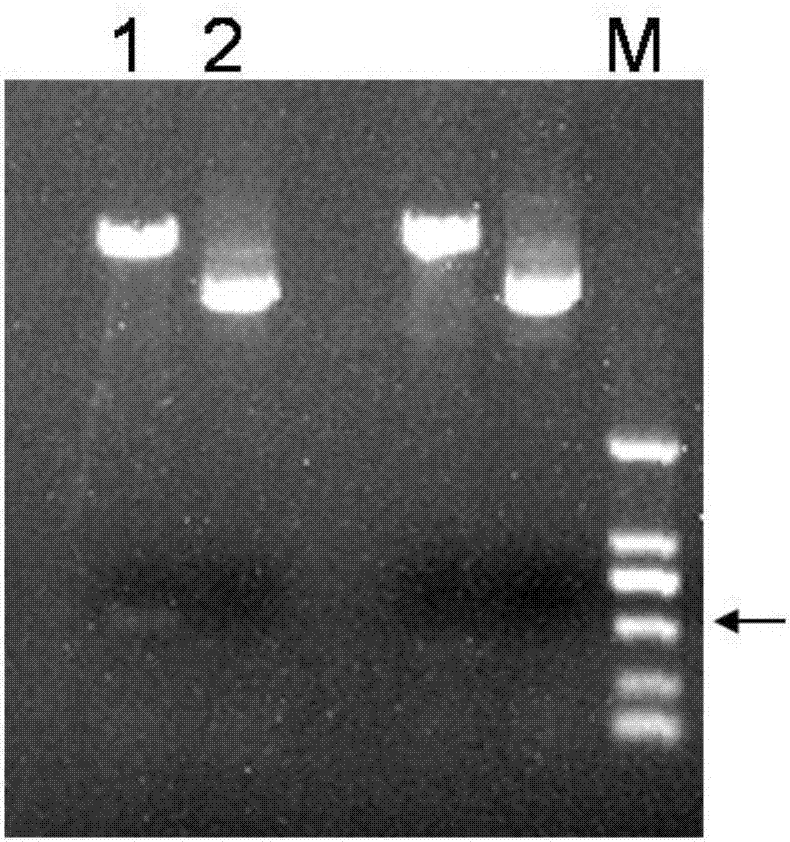Photoinduced promoter gene and application thereof
A light-induced and promoter technology, applied in the field of genetic engineering, to achieve the effect of solving food safety problems
- Summary
- Abstract
- Description
- Claims
- Application Information
AI Technical Summary
Problems solved by technology
Method used
Image
Examples
Embodiment 1
[0037] Example 1 Synthesis and sequence analysis of rice light-inducible promoter p727 fragment
[0039] Unexpectedly, the inventors found that in Nipponbare of ssp.japonica of Oryzasativa (rice), the promoter p727 (SEQ ID NO.1), which contains the OsrbcS gene and intron sequences, contains multiple light-responsive cis-acting elements As well as the essential elements of the promoter, it was found through follow-up experiments that unexpectedly, the promoter p727 also has light induction and leaf tissue specificity, and the exogenous gene can be specifically and moderately expressed in the leaves of transgenic rice. Roots, seeds (embryo and endosperm) not expressed in.
[0040]Hind III and Xba I restriction sites were introduced at both ends, and the p727 fragment was artificially synthesized after the corresponding sequences were amplified from the rice genome. The p727 fragment of the promoter is a 417bp restriction product ( figure 1 ), in t...
Embodiment 2
[0044] Embodiment 2 constructs and transforms the recombinant binary expression plasmid (such as image 3 shown);
[0045] 1. Extract the plasmids of p1300-GUSplusNOS and p-OsRBCS-727 (Axygen plasmid mini-prep kit). p1300-GUSplusNOS was transformed from pCAMBIA1300 binary expression vector (purchased from CAMBIA Company), the GUSplus-NOS gene was added between the Kpn I and EcoR I restriction sites, and there was no promoter sequence upstream.
[0046] 2. Double digestion of p1300-GUSplusNOS plasmid and p-OsRBCS-727 plasmid with restriction endonucleases Hind III and Xba I (purchased from NEB Company).
[0047] 3. Gel recovery (Axygen Gel Recovery Kit) p1300-GUSplusNOS digested plasmid and promoter p727 fragment, ligated at 16°C for 30 minutes (T4 ligase, purchased from NEB Company), and transformed into Trans10 competent produced by Quanshijin Company In the cells, the positive clones were selected by smearing, and the promoter amplification primers were used for sequencing...
Embodiment 3
[0048] Example 3 Agrobacterium-mediated genetic transformation of rice and positive detection of transgenic plants
[0049] The plant expression vector p-OsRBCS-727:GUSplus constructed in Example 2 was transformed into the Agrobacterium tumefaciens strain EHA105 (gifted by Nanjing Agricultural University) by the cold shock method, and then infected with the japonica rice variety Nipponbare (Nipponbare of ssp.japonica of Oryza sativa (rice)) mature embryo-induced callus.
[0050] After co-culture, they were selected with 50 mg / L hygromycin.
[0051] Operations such as rice tissue culture, Agrobacterium-mediated transformation, selection of resistant callus and plant regeneration refer to general methods in the field.
[0052] Positive plants were positively detected by PCR method, and the primers were all internal primers of GUSplus gene (see below). The product size is 400bp.
[0053] GUSplus-F:5'-TAGTTTTTCTCTTCATTTTCT-3'SEQ ID NO2;
[0054] GUSplus-R: 5'-GCTTGTTACGAATGACT...
PUM
 Login to View More
Login to View More Abstract
Description
Claims
Application Information
 Login to View More
Login to View More - R&D
- Intellectual Property
- Life Sciences
- Materials
- Tech Scout
- Unparalleled Data Quality
- Higher Quality Content
- 60% Fewer Hallucinations
Browse by: Latest US Patents, China's latest patents, Technical Efficacy Thesaurus, Application Domain, Technology Topic, Popular Technical Reports.
© 2025 PatSnap. All rights reserved.Legal|Privacy policy|Modern Slavery Act Transparency Statement|Sitemap|About US| Contact US: help@patsnap.com



